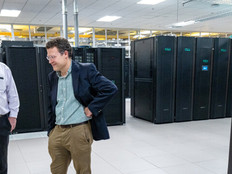Heads up! Solar Cycle 25 is here. This 11-year cycle of the sun’s activity is expected to reach its peak in 2025, with solar flares and eruptions that can wreak havoc on Earth. Intense currents driven by space weather can have severe impacts, damaging or destroying critical infrastructure, interrupting the internet and other communications and leading to power outages.
The federal government is already making plans to prepare for and respond to the next big solar storm. The Federal Emergency Management Agency even has a handbook on what agencies should do in response to a solar weather event, including recommendations on how to protect data and prepare for lengthy power outages and surges.
Solar Weather Impacts Can Be Devastating
History shows that solar storms can cause real havoc. In 1989, most of Quebec was darkened for more than 12 hours by blackouts caused when a massive solar storm shut down the province’s power grid. Radio transmissions were also scrambled.
Click the banner below to learn about defending your data.
Imagine what would happen today, in a world reliant on the internet. The planet got a small taste in early August, when a large, disruptive solar flare interrupted high-frequency radio communication on the sunlit side of Earth.
While upcoming solar weather events are not likely to lead to an “internet apocalypse” (as one University of California professor suggested), it is good to be prepared for probable interruptions and ensure processes will continue to run, even with less power or a lack of connectivity.
Federal agencies should look to uninterruptible power supplies and surge protection devices to defend their systems from disruptions due to solar weather events or other potential disasters.
Uninterruptible Power Supplies Provide Energy During Outages
A UPS is a backup system that can protect workloads and hardware. When power is lost, the UPS kicks in and supplies adequate power until longer-term emergency power backup systems are available.
During an outage, the UPS detects that power is no longer coming from the grid and switches to battery power. Online double-conversion UPSs (such as the Schneider Electric Galaxy and Eaton Powerware devices) do this immediately.
Other types, such as line-interactive and offline/standby UPSs, may experience a slight delay. These convert energy stored in the battery into AC power and deliver it to the connected load unaffected by the outage. Once power is restored, the UPS transitions back to using utility power as its primary source.
DEEP DIVE: Read about the options for as-a-service solutions in data storage.
Make sure to test the devices on a quarterly or semi-annual basis to address issues before they become critical. Test the UPS’s functions, including its ability to switch to battery power seamlessly. Test batteries more frequently, about every three to six months. It’s also wise to conduct unannounced tests to simulate a real outage.
13
The number of major solar events observed so far during Solar Cycle 251
Source: nesdis.noaa.gov, “Time-lapse of Solar Cycle 25 displays increasing activity on the Sun,” June 2, 2023
How to Protect Against Dangerous Power Surges
A sudden (even transient) power surge can be forceful enough to damage or destroy data servers, resulting in lost data, broken equipment and costly downtime. A surge protection device ensures that sensitive equipment is shielded from the damaging effects of transients, surges or spikes.
When the surge protection device detects a voltage surge, it responds rapidly — usually in nanoseconds — by diverting excess energy away from the connected equipment. Surge protectors also provide voltage clamping, which keeps the voltage at a certain threshold and ensures that it remains at safe levels across all protected equipment.
When choosing a surge protector, make sure it meets your specific requirements, has adequate response time, provides multistage protection and complies with relevant safety and performance standards. Schneider Electric, Leviton and Tripp Lite all sell industrial-grade surge protection devices.
A word of warning: Although an industrial UPS will provide secondary surge protection, it should not be considered a primary surge protection device.
EXPLORE: How agencies can best foster a security culture.
As with the UPS, regular testing of surge protectors is a must. Functional testing —introducing controlled surges and verifying the response — ensures proper operation. Be sure to schedule response time testing and surge current testing. If your surge protector comes with battery backup, also test the battery capacity and charging functionality.
Industrial strength UPS and surge protection devices can go a long way toward making sure your critical equipment continues to function normally during a power outage, surge or severe weather event.
When it comes to space weather, Jake Bleacher, chief exploration scientist for NASA’s Human Exploration and Operations Mission Directorate, reminded people in 2020, during the early days of the solar cycle, “there is no bad weather, just bad preparation. Space weather is what it is — our job is to prepare.”












